
A cotton filled pillow seems like it’d be pretty comfortable right?
I’ve been manufacturing and selling pillows for many years. In an effort to make the best products possible, I’m consistently buying and testing different types. I thought I’d tried almost everything, but recently someone asked me about cotton filled pillows, “are they comfortable?” I honestly didn’t know. I’d never come across a cotton pillow, which seemed odd, given that cotton is one of most popular materials in the world.
I don’t live under a rock, so I was already familiar with the texture of unspun cotton: it’s soft and compressible similar to other traditional pillow filling like down. It seemed safe to assume that a cotton-filled pillow would be reasonably comfortable. I committed to finding a nice one online.
Surprisingly, cotton filled pillows aren’t easy to find.
Given cotton’s ubiquity, I figured that pillows filled with it would be reasonably popular. Apparently they once were, but advancements in technology introduced popular new synthetic pillow filling types like memory foam, and polyfill. These materials have relegated cotton to a minority position as pillow filling.
Note: I’m not a fan of these modern petroleum-based pillow fillings. Most are not biodegradable and some are potentially hazardous to your health. Thus, cotton-filled pillows seem like a good healthy and eco-friendly alternative.
After comparing the few products available, I finally decided on what seemed to be the best available standard size (20×26”) organic cotton filled pillow.
After a couple days, the pillow arrived at my door and my helpful children tore into the box for me. They’ve both slept on hefty buckwheat pillows their entire life, so this light and fluffy thing was immediately impressive to them. I was a little more skeptical.
How does it feel? Soft/Firm/Malleable?
First, I was surprised that the pillow wasn’t more squishy. While “soft,” is an accurate adjective to describe cotton, relative to some other popular pillow fillings, it felt rather firm. Down and polyfill, for example, offer far greater compressibility.
Mind you, a firm pillow can be preferable for many, if it is also malleable. A malleable filling will conform to the shape of your shoulders, neck and head. Even support of your head’s weight will eliminate uncomfortable pressure points (and help you sleep). Unfortunately the cotton filling in my pillow didn’t seem very malleable. It had a relatively constant form when packed into a pillowcase. Its rectangular loaf-like shape wasn’t easily changed.
The pillow I purchased is adjustable, thanks to its zippered opening.
The fabric case included a zippered opening along one end, allowing me to easily add or remove the cotton filling. This way I could adjust the loft (thickness) of the pillow to accurately position my head off the mattress. As a side sleeper, I tend to prefer a medium to high loft pillow. This pillow’s loft seemed just about right for me out of the box, so I didn’t need to remove any of the cotton filling. Those that prefer a thicker pillow would need to purchase additional cotton filling (or find another pillow) to give it more loft.
The fabric case was durable and the cotton packed inside seemed to be of high quality.
I opened it and found that the cotton filling was a uniform and consistent density. It didn’t concern me, but it was interesting to see a few foreign materials that were left behind in the milling process within the cotton. It didn’t look like the bleached white cotton balls I expected.
I was unable to find conclusive advice about cleaning it. However, it appears that it is feasible to wash a cotton pillow if you:
- rinse repeatedly to remove all soap from the cotton filling and
- thoroughly dry it; it’s very easy for mildew to grow inside as cotton will hold a lot of moisture.
Cotton pillows don’t smell!
A new pillow obviously shouldn’t smell bad. Unfortunately many of the most popular pillows available do. Modern pillow filling like memory foam can emit a powerful glue-like smell due to a manufacturing process involving petrochemicals. The first time I tried a memory foam pillow I was shocked at its overwhelming odor. Manufacturers call this “off-gassing.” Fortunately my cotton pillow had no discernible odor.
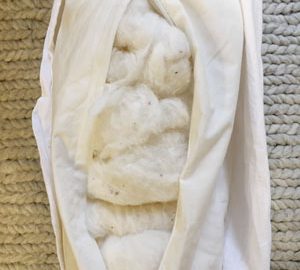
My cotton pillow after 1 month of sleeping and 4 months of pillow forts.
I slipped my new cotton pillow into a pillow case and gave it a test run.
I’ve got several types of pillows laying around the house to use as A/B test subjects, so it was easy to compare it to the competition.
1. Cotton filled pillows are not as supportive as some other pillow types.
As I mentioned above, my impression when it came out of the box was that it didn’t seem very malleable. My suspicion was correct. I tried to adjust the cotton filling; pushing it toward the edges in an effort to make an indentation for my head. The cotton filling is mashed, tangled and twisted into one large rectangular piece that stubbornly holds its shape. It isn’t capable of offering the same uniform support that a moldable pillow filling like down or buckwheat hulls can provide.
With soft pillow filling like down, “fluffing” it opens space between the feather filling, making it thicker (and softer). Having fluffed a down pillow, you can sink your head into it, pushing the feather fill to the edges, which wrap around your head providing excellent support. I tried this technique with my cotton pillow. Again, the cotton filling proved resilient to adjustments.
The lack of support had me constantly readjusting both my pillow and sleeping position.
2. Cotton filled pillows are cooler than most pillow types (but not all).
I’ve written extensively about different pillows’ ability to stay cool. It’s pretty simple really: breathable pillows are cool pillows. Pillow filling types that allow air to circulate freely will permit warm humid air to quickly escape, keeping your pillow comfortable all night long. Conversely, pillow fill types that restrict airflow tend to build up and retain body heat.
All pillows absorb your body heat. Some types of pillow filling like memory foam can retain that heat for over a half an hour. Other breathable pillow filling like buckwheat hulls allow the warm air to escape quickly in just 5 minutes.
It turns out that cotton-filled pillows are more breathable than the most popular pillow types including memory foam, down and polyfill.
I did simple tests with a laser surface thermometer. At room temperature, my cotton pillow’s surface temperature was 76 degrees. Next, I rested my head on the pillow for 15 minutes and took another surface temperature reading: 91.5 degrees. The cotton pillow reverted to room temperature in 22 minutes. It shed its warmth twice as quickly as my memory foam pillow. Not bad.
On the other hand, the cotton filling couldn’t compete with the breathable filling of a buckwheat pillow which returned to room temperature in only 2 minutes!
3. Cotton pillow filling has a significant disadvantage: it clumps and flattens with use.
Initially I had no complaints about clumping or flattening. My cotton pillow seemed like it was uniform in shape and compressibility and elasticity. It also seemed to have enough loft to support my side sleeping position relatively consistently. I kept sleeping on it for 3-4 weeks, despite being generally unhappy with it, because it can take awhile to get used to a new bed pillow. After finally giving up, it made its way into my kids’ pillow fort construction. The pillow has been kicking around our house for almost 5 months. It is clumping (see photo), making it feel lumpy and less malleable than it was when new. The pillow is also thinner; it used to have sufficient loft to keep my head elevated properly, but now it’s too thin.
Some manufacturers recommend that you put your cotton-filled pillow into the dryer for 20 minutes to facilitate the fluffing process. As I write this, it is tumbling in my dryer with a tennis ball… *beep* Having been in for 20 minutes, it is slightly more plump, both softer and thicker. It is however, still too thin, and the clumping issue persists 🙁
Cotton Conclusions
I’m acclimated to buckwheat pillows, which offer support that’s superior to any other pillow filling I’ve tried, so the cotton filling was a bit of a disappointment. To those who are accustomed to soft, squishy pillow filling like down, a cotton pillow might be more impressive.
If you prefer a soft pillow and aren’t open to trying anything else but soft, you’ll probably prefer a down pillow to a cotton one. That said, cotton pillows have their place. I would recommend them for those who:
- are allergic to down. Although quite rare, these allergies do exist.
- live a vegan lifestyle. Duck feather plucking is not required on the cotton farm!
- have a concern for the environment. Cotton pillows are biodegradable. Thus, they are a much more ecologically sound alternative to petroleum-based products like polyfill and memory foam (note that the production of traditional cotton can result in some unacceptable pollution as well. Thus, certified organic cotton grown and produced under strict standards are preferred).
For me, the lack of malleability was the cotton pillow’s biggest flaw.
No matter what I tried, I couldn’t make it stay in the shape I wanted and as a result I wasn’t getting the best sleep. It made me wonder if a pillow filled with thousands of cotton balls would be more comfortable… would it be more malleable? I have been surprised to find that the shredded varieties (material torn into tiny pieces) of latex, memory and poly foam filling are considerably more comfortable than the solid single piece alternatives. Maybe I should head down to the drug store and buy some cotton balls for my next pillow experiment!
If you’re looking specifically for a “soft” alternative to down or petrochemical fill, cotton (or kapok) could be a good option for you. It’s safe, doesn’t have any chemical odor, and is eco-conscious.
For those who are open to non-tradional (firm) solutions, I think that there are far better options:
… like our own Hullo™ buckwheat pillow! Give one a try and I think you’ll agree that it’s superior to other pillow types. Don’t take my word for it — check out these customer reviews.

Pull up a zafu and relax!
The word zafu is frequently translated as, “sewn seat.” However, a strict interpretation of the Japanese kanji is “reedmace seat.”
What’s Reedmace?
Better known in the U.S. as cattails, reedmace flowers produce a fluffy down-like material that can be used to fill pillows. Reedmace was once popular as zafu pillow filling due to its firm and durable characteristics.
Reedmace never caught on as pillow filling. In fact, it’s very difficult to find an authentic reedmace-filled zafu. That’s not a problem, because there’s a far more practical and comfortable option: buckwheat hulls.
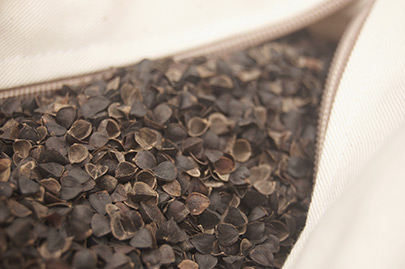
Buckwheat hulls are a proven pillow and upholstery filling made popular with centuries of use in Asia.
Thousands of tiny all-natural buckwheat hulls provide support for your body that can’t be matched by other pillow fillings. The unique malleable characteristics of buckwheat hulls allows them to conform perfectly to the shape of your body.
Buckwheat hulls move and shift, but do not compress under pressure and lose volume or loft. A buckwheat filled zafu can be easily molded and shaped as you please thanks to the irregular edges of each individual buckwheat hull. The hulls gently grip one another, enabling your pillow to hold a shape that mimics the contour of your body, keeping you positioned consistently and comfortably.
Zafu meditation cushions are sometimes filled with kapok or foam. Avoid these.
These soft fillings will compress substantially under the weight of your body and thus cannot hold their shape. Maintaining a neutral and comfortable posture is difficult if your zafu is too thin or inconsistently shaped.
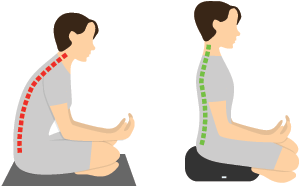
It’s difficult to maintain good posture while seated on a flat surface.
How does a zafu work and what are the benefits?
A zafu improves your posture by making small adjustments to the geometry of your typical seated position.
While seated on a flat surface, our natural inclination is to bend our backs forward while hunching our shoulders. Sitting with this flawed posture will inevitably cause painful stress on joints, muscles and nerves.
A zafu, placed under your hips, will elevate your upper body slightly. It allows you to effortlessly straighten your spine and pull your shoulders back into a healthy posture. This simple enhancement keeps your spine neutrally aligned and will help to eliminate any potentially uncomfortable pressure points in your back, shoulders and neck.
Zafus are most typically cylindrically shaped. They are often about 12-18″ wide and 5-8″ tall. Their circluar shape allows your legs and/or feet to tuck in along the front edge (your feet will catch on a rectangular pillow’s corners).
Where can I use a zafu? They’re useful in many contexts:
- Quick and Convenient Seating for Your Home – Sometimes also called a pouf or a floor pillow, a zafu will add stylish, compact and comfortable accommodation to any room of the house. Adults can sit on them together comfortably around the coffee table with drinks while the kids use them for lounging in front of the latest movie.
- Posture Perfect – A zafu’s shape encourages excellent posture, making them ideal for use during yoga and meditation.
- Comfort on the Go – Take your zafu with you camping, to the kids’ soccer games or to the picnic in the park. Many zafus include a durable carrying handle making them easy to take along wherever you go.
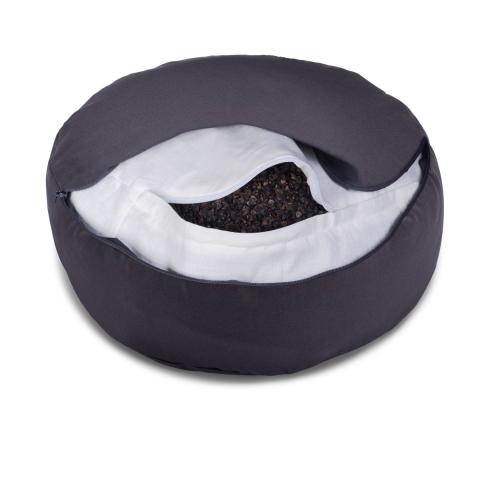
This Hullo™ zafu includes a liner, which makes it easy to clean its fabric outer shell.
A zafu will eventually get dirty. Make sure you can clean it.
Exposure to dirt and dust will inevitably occur; at some point, you’ll want to clean your zafu.
Spot cleaning stains with a damp rag will keep it in reasonable condition.
However, to properly clean a zafu, you’ll need to completely remove the filling. Next, machine wash the outer fabric shell. To do so, your zafu will need a zippered opening, a feature unfortunately not all include.
The best zafus also have an interior breathable liner containing the buckwheat hulls. These allow you to quickly and conveniently remove and replace the buckwheat from the outer fabric shell without any spills.
High-quality materials and construction matter!
Sitting on a zafu can put a lot of pressure on the zipper and seams holding your pillow’s filling in place. I have experience with cheaply made pillows. My first buckwheat pillow split open at the seam and lost its filling all over my bedroom floor!
The pillow with the lowest price tag isn’t always the most economical. A well-made product will often save money in the long run, even if it costs more up front.
You can make your own zafu.
A zafu is a bit more challenging to make than a traditional square pillow. If you’re an avid DIYer and ready for the challenge, check out this simple zafu design and tutorial. We sell pillow-grade buckwheat filling in 10 and 20 lb
What’s the best zafu? Try Hullo.
We recently started selling a zafu meditation cushion alongside our Hullo™ bed pillows, calling it a floor pillow:
- 13″ × 13″ × 5″ – 4 pounds, 13 ounces
- 100% Certified organic cotton twill – Stain-resistant, preshrunk, machine-washable
- Durable locking Dunlap zipper and integrated convenient carrying handle
- Zippered internal liner makes washing the cover a breeze
- Premium buckwheat hulls – Grown & milled in the U.S.A.
- High-quality YKK™ auto-locking hidden zipper
- Fast, free shipping via UPS – in-stock
- Cut & sewn in Minnesota, U.S.A.
Give one a try for 60 days. If you’re not sitting more comfortably, just send it back to us for a refund.
55% of the U.S. population tests positive to one or more allergens. Allergies are such a pain in America’s ass that the allergy treatment and management market generates annual revenues in excess of 6 billion dollars!
Pillow manufacturers want some of that wonderful cash, so they frequently market their products as being hypoallergenic. These claims really resonate with consumers. If you’ve experienced any inconvenience related to allergies, a hypoallergenic pillow can sound like a smart purchase if it can prevent potential allergic reactions.
So many hypoallergenic pillow choices…
At the present time, 10% of the bed pillows available at Amazon.com use the term “hypoallergenic” in their descriptions. In fact, every popular type of pillow claims to be hypoallergenic including: down pillows, memory foam pillows, poly foam pillows, buckwheat pillows, microbead pillows, latex pillows, water pillows, kapok pillows and millet hull pillows.
The fact that all these different pillows claim to have hypoallergenic qualities suggests that there’s a little bullshit in the air.
What is a hypoallergenic pillow anyway?
Unfortunately calling any product hypoallergenic is a relatively hollow claim. That’s because there is no regulation in the United States that defines or governs the use of the term. Consequently hypoallergenic pillows can be advertised with impunity. Pillows that are no better or worse at resisting allergens are labeled hypoallergenic without consequence.
A medical dictionary provides a somewhat vague definition:
“Hypoallergenic” – Adjective
A term applied to a preparation in which every possible care has been taken in formulation and production to ensure minimum instance of allergic reactions. Blakiston’s Medical Dictionary
Has “every possible care been taken,” to prevent allergic reactions in these hypoallergenic products?
Some hypoallergenic claims seem more legitimate than others.
Most hypoallergenic pillow’s descriptions are rather cryptic and vague. On the other hand, some explain in detail the supposed hypoallergenic benefit and how it’s achieved. They cite specific manufacturing techniques or have detailed scientific explanations that can be rather convincing. For example, down pillow filling (often unfairly characterized as allergen-prone) is sometimes described as having been washed to remove the goose dander.
Unfortunately, no comprehensive study exists that shows any single type of pillow being more (or less) effective at preventing allergic reactions.
The scientific studies that compare hypoallergenic bedding products show contradictory and inconclusive results. Get this—allergists at Ohio State University found that some so-called hypoallergenic pillows might actually be less effective than traditional feather pillows.
“… side-by-side tests of pillow types show that so-called “anti-allergy” pillows can cause more allergic reactions than feather pillows. It is a widely held belief that feather pillows cause allergic reactions, but studies show that the porous materials used in some synthetic pillows can actually retain more mold and dust mites than feather pillows.” –LiveScience.com
A lack of consistent evidence makes determining the best type of hypoallergenic pillow difficult. Being that the case, I recommend you simply tune out the confusing hypoallergenic noise.
Not coincidentally, the materials used in the construction of the most popular pillow types are all relatively benign. Allergies to the materials used in pillows do exist of course, but they are rare. If you’re allergic to something, you’re allergic! Treating it with a special process or wash that supposedly makes it hypoallergenic won’t change its potential to annoy the hell out of you!

I’ll poop in your bed!
Dust mites are the true allergy menace and no pillow type is immune to them.
Dust mites are one of the top five most common allergens. The effects of a dust mite allergy are very similar to a pollen allergy except that the symptoms occur year round instead of just seasonally.
“Dust mites are microscopic creatures, about 0.4 millimeters in length, that feast on flakes of human skin. Their feces contains a substance called DerP1, a very potent allergen. People who are allergic to dust mites may have asthmalike symptoms, eczema or chronic sinus problems.” NYTimes.com
If you’re experiencing an allergic reaction to a pillow that you’ve been using for awhile, chances are you’re allergic to dust mites, not the pillow itself. That said, while dust mite allergies are common, it’s not always obvious. This ambiguity benefits hypoallergenic pillow manufacturers. Consumer’s uncertainty about allergen facts makes their broad claims of hypoallergenic benefits look very appealing.
You might be allergic to dust mites if you experience any of the following symptoms:
- headaches,
- congestion,
- sneezing in the morning, or
- scratchy eyes.
To be sure, you can take an allergy test. Most insurers will cover the cost and they take only about an hour to complete.
Hypoallergenic pillows are not immune to dust mites.
All pillows, with use, will accumulate particles of organic material from your body that dust mites crave. Every night you sleep on your pillow, you leave behind delicious dead skin for dust mites and their families!
What can you do to avoid dust mites?
- Lower the humidity in your home. Dust mites only appear in humid environments. You’re not likely to have dust mites if your home is kept with a relative humidity of less than 50%.
- Use dust mite covers. These are generally vinyl or plastic covers that prevent foreign materials from getting inside your pillow. While most experts recommend them, they are still somewhat controversial. An unfortunate drawback to dust mite covers is that they will prevent air from moving freely through your pillow. This can result in it retaining heat and being uncomfortable.
- Take extra care to keep your pillows clean. Wash your pillowcase frequently and your pillow too, if possible.
Should I be concerned about dust mites if I’m not allergic?
I’ve read some pretty shocking claims about pillows full of pounds of dust mite corpses and their feces. The fact is these stories are exaggerated and dust mites aren’t something most of us should be concerned about. They will not take up residence in your bedding unless the circumstances are just right. Even a few of them do, they’re not going to cause any trouble unless you’re allergic to them.
Ultimately, you don’t need a so-called hypoallergenic pillow.
Instead of sleeping on a pillow that is unnecessary or even counter-productive, just apply this simple logic:
- Choose a pillow that’s comfortable and suited for your sleeping position.
- If you’re allergic to down or some other specific material, try a pillow made with something else.
- If you’re allergic to dust mites, take precautions to prevent them from .
Don’t believe any claim that a pillow is capable of preventing allergic reactions. In fact, all pillows can accumulate mold, bacteria and dust mites. Unfortunately allergens are everywhere. No pillow has a magical force field that can protect it from being exposed to them.
A note specifically about buckwheat pillows.
In case you hadn’t already guessed, we make and sell buckwheat pillows. We love them because we believe they’re the best type of pillow, but they don’t have any magical anti-allergy powers. Many of our competitors describe their products as being hypoallergenic. There’s no evidence to suggest they’re any better than any other pillow type at preventing allergic reactions. We do not advertise or describe our products as being hypoallergenic.

“I’m going to microwave these buckwheat hulls. Then I’ll roast some rocks and sand in my oven.”
We frequently get emails from customers wondering, “can you put buckwheat hulls in the microwave?” Yeah but…
Buckwheat hulls should not be heated in a microwave. They don’t effectively retain or conduct heat, so there’s really no reason to do it. Yes, they’ll warm up a bit, but buckwheat hulls are far from effective at storing heat energy. What little warmth is retained after being pulled out of your greasy microwave will quickly dissipate as cool air circulates between the hulls.
Microwaving buckwheat hulls will damage them.
Heating buckwheat hulls at high temperatures will result in a reduction of the moisture they contain. Dry hulls become brittle and as a result, they are easily crushed, which negates some of their benefits. Flattened or crushed buckwheat hulls can cause a couple (small) problems:
- The buckwheat hulls will lose some of their volume. Your pillow may feel flatter and not provide the support it once did.
- The crushed buckwheat hulls will not be as malleable as they once were. They will not grip one another like intact hulls do. As a result, your pillow won’t hold its shape as well as it could.
Also worth considering… Most quality buckwheat pillows have a metal zipper, so unless you enjoy fireworks, keep it out of your microwave oven!
Microwaved buckwheat hulls are simply not effective at retaining heat and thus make it a poor filling for heating pads. What’s more, it’ll degrade your magical buckwheat hulls. They’d be better off used in a bed pillow, so you really shouldn’t bother.
If you’re interested in heat therapy, rice is the way to go.
Rice won’t work well as pillow filling because it’s far too dense. It will not conform to the shape of your head without a lot of effort. It will, however, effectively store heat energy. Rice, inside a small fabric container, can be microwaved and used as a heating pad. I’ve never tried it myself, but it will apparently stay warm for almost an hour. Make your own reusable rice heating pad.

“If only I had an orthopedic or cervical pillow to keep my head and neck positioned correctly…”
Orthopedic Pillow? Cervical Pillow? What are these things?
If you’re reading this page, you’ve probably got at least a vague idea of what an orthopedic pillow is. Also referred to as a cervical pillow, they’re “designed to correct body positioning in bed or while lying on any other surface.” -Wikipedia
They’re sometimes also referred to as therapeutic pillows based upon claims that they can relieve conditions such as neck pain, sleep apnea, or insomnia.
Orthopedic pillows come in many sizes and shapes and serve different purposes.
The most popular orthopedic pillows are rectangular (usually conforming to the standard pillow dimensions of 20×26″) and are intended to fill the space between your head and the mattress. Not all orthopedic pillows are intended to support your head and neck however. Some are designed for more unique circumstances, like elevating your legs or back. We’ll be looking specifically at orthopedic bed pillows intended to provide head and neck support…
If orthopedic pillows are intended to correct your body positioning, what’s “correct?”
It’s simple really: unnatural bends and twists in your neck and back can cause muscle strains and put pressure on nerves and discs. Your spine is best off when it’s straight. Keep your spine straight and you’ll potentially avoid agitation and sleep more soundly.
Your pillow’s job is to support your head and neck. It, ideally, keeps your body in what’s called a neutral sleeping position. A neutral sleeping position keeps all the bits and pieces in your back and neck in in their ideal positions. This helps to prevent unnecessary pressure on your discs, muscles and nerves. Keep your spine neutrally aligned and you’ll avoid discomfort (or worse).
“But I used to sleep so well,” you say… Sleeping twisted up like a pretzel on a futon filled with hay and beer cans may have worked when you were 20. Unfortunately, as we age, the padded discs between our vertebrae wear out and we become more sensitive to our sleeping conditions. Orthopedic pillows can make sleeping a little easier on our sad, worn-out bodies.
What’s incorrect about the way traditional bed pillows position your head and neck?
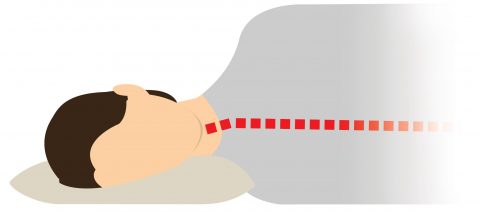
If your pillow doesn’t keep your head at the correct level, it is likely you will experience back and neck pain.
1. A pillow with incorrect loft (thickness) will position your head too high or low.
If your pillow is too thin, your neck may bend downward at an awkward angle. Conversely, if it’s too thick, your neck bends unnaturally upward. Both situations can cause pain.
2. A pillow that’s too soft will inconsistently support your head and neck.
Traditional soft bed pillows filled with down or polyester foam often collapse under pressure and can not support your head adequately throughout the entire night.
Additionally, a soft pillow won’t provide the best lateral support your head. A soft pillow filling will change shape under the weight of your head and won’t prevent your head from turning left or right, particularly if you’re a back sleeper. This will result in lateral twists that can cause pain.
To get better rest, consider an orthopedic pillow.
If your head is supported in a neutral position, the muscles in your neck and back will be able to to completely relax. Pressure on your discs and muscles will be diminished and, as a result, you’ll get better rest. Orthopedic pillows can offer superior support for your head and neck, allowing you to get the best rest possible.
The most effective orthopedic pillows are:

A typical contour or cervical pillow. It sure looks weird, but it could be an improvement over your sorry old pillow.
1. Contour pillows
Contour pillows (AKA cervical pillows) are most often made of polyether foam, latex or memory foam.
They can be more effective than traditional soft pillows because:
- their unique concave shape efficiently cradles your head and neck, helping to keep them positioned consistently all night long.
- their firm filling allows them to maintain the proper loft without flatting out under the weight of your head.
While contour pillows can keep your head and neck consistently positioned correctly, they do come with some disadvantages.
Most contour pillows are not adjustable.
One of the biggest problems with foam and memory foam pillows is that they come in a predefined geometric shape. They will collapse and conform to you head somewhat, but they cannot be squished shaped or molded to support a wide variety of sleeping positions. Many people change positions throughout the night. Unfortunately, a preformed foam pillow is not shaped optimally for many of these positions. You typically can not adjust the pillow thickness of a foam pillow. Depending on your body shape, the firmness of your mattress and your sleeping positions, a contour pillow may be too thick or thin for you.
Most contour pillows are not breathable.
They are typically made from non-breathable materials. The lack of air circulation causes uncomfortable heat build up. As a result, it will slowly absorb and retain your body heat. Given their unique shape, there’s no flipping to the cool side!
Consequently, manufacturers strive to improve breathability by perforating the pillow with a grid of holes. This can be effective, although they’re still inferior to most other pillow types at staying cool.

Buckwheat pillows are the superior orthopedic pillow.
2. Buckwheat Pillows
We are huge fans of buckwheat pillows. The buckwheat hull filling makes them uniquely capable of proper head and neck support. The thousands of tiny hulls perfectly conform to the space between your head and the mattress, eliminating potentially pain-causing pressure points in your neck and back. Buckwheat pillows offer firm, consistent support that will keep your head and neck comfortably positioned all night long.
Buckwheat Pillows Are Adjustable.
High-quality buckwheat pillows always have a zipper. A zipper enables adjustment of the amount of filling in the pillow. As a result, you’re able to change the thickness of your pillow for maximum comfort by adding or removing buckwheat hulls.
Buckwheat Pillows Are Breathable.
The irregular and hollow shape of buckwheat hulls creates airspace within your pillow. Its breathable nature results in a cool, dry pillow, that gives you the “cool side of the pillow” effect all night long.
Buckwheat Pillows Are Made from Natural Renewable Materials.
Many popular pillow types contain polyurethane or polyester foam that can emit toxins and carcinogens that aren’t good for you or our environment. There’s no sense in risking your health or filling our landfills with potentially toxic waste!
Moreover, buckwheat crops benefit little from chemical fertilizers. It is free of many of the contaminants that are present in other crop types and is safe for your family and the environment. The hulls are compostable, which helps to reduce unnecessary waste in our landfills and keeps our soil healthy and nutrient rich for future generations. Additionally, buckwheat pillows contain no animal products for those interested in a vegan lifestyle.
My Recommendation: Try a Hullo Buckwheat Pillow for 60 Nights.
I’ve been sleeping on buckwheat pillows for years and haven’t experienced a single bout of sleep-related discomfort since. In fact, I like these unique pillows so much that I decided to manufacture and sell them.
Try a Hullo buckwheat pillow for 60 nights. If you don’t care for it, just ship it back to us and we’ll refund the purchase price. Don’t take my word for it, read the reviews our customers have posted.
Read More:
- Pillows for Neck Pain
- What Are the Benefits of a Buckwheat Pillow?
- Contour Pillows — Why Buckwheat Is Better than Memory Foam

Are you buried in bed pillow options?
The best selling bed pillows are primarily variations of traditional poly fiberfill pillows. Not coincidentally, these pillow types are also the cheapest options available. Unfortunately they’re not capable of providing you with the best rest you can get.
The most popular cheap fiberfill bed pillows:
- collapse under the weight of your head during the night, potentially causing an uncomfortable downward bend in your neck and spine.
- require consistent refluffing or readjustment to maintain their loft and support.
- absorb and retain body heat, making your pillow feel hot and humid.
- are not durable, requiring frequent replacement.
It should come as no surprise that the best bed pillows aren’t the cheap ones!
The best bed pillows will allow you to get the most out of your sleep.
An intimate part of your daily routine is spent with your head and neck pressed into your pillow. If you’ve conceded to a crazy low price on a substandard pillow, you’ve compromised the quality of 1/3 of your life! All for just a few pennies in daily savings? Don’t do that! Given the frequency that you utilize this essential device, you should carefully consider the comfort the quality of rest that can provide you.
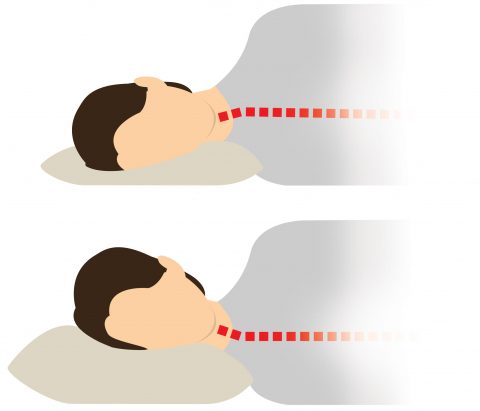
If your pillow’s loft is incorrect, it is likely you will experience back and neck pain.
What’s the best bed pillow loft?
Loft? What’s loft? Loft refers to the height of the pillow. Your pillow’s loft determines how high your head is elevated off the surface of your mattress.
Your pillow’s job is to fill the space between your head and your mattress while keeping your body in a neutral sleeping position — your neck and back should be in a straight line without any upward or downward bends in your spine.
Unnatural bends and twists in your spine can cause muscle strains and put pressure on nerves. Your spine is best off when it’s straight, so choosing the proper loft is important.
Side sleepers will get the best rest on high loft bed pillows.
Side sleepers are advised to use a pillow with more loft (thickness) than other pillow types. This is simply because there is more space to fill between your head and the mattress when on your side than when on your back or stomach.
Stomach and back sleepers will prefer a low loft bed pillow.
Many pillows are simply too thick for back and stomach sleepers. A thinner, low loft pillow type will properly elevate your head and neck.
Adjustable bed pillows allow you to fine-tune the loft to your preference.
With an adjustable pillow, it doesn’t matter if you’re a side, back or stomach sleeper; it will accommodate all sleep positions and body types. An adjustable pillow allows its fill to be added or removed so it can be dialed in to your personal preference. As long as the case has a zippered opening, you can add or remove whatever you want until you’ve perfected the pillow’s loft (thickness).
What’s the best bed pillow filling?
Your pillow’s filling defines its character. Depending on the type of fill and the quantity used, your pillow can be totally unique and appropriate to your preferences: soft, firm, supportive, low or high loft—it’s your choice.
No single pillow filling type works for everyone.
There are a few too many options, not all of them good. I’m not a fan of synthetic petroleum-based foam pillow filling. The all natural options are as good if not better and side-step all issues of toxicity and health hazards associated with synthetic filling. For that reason, I do not recommend any of the popular synthetic options like memory foam, poly foams/fiberfill or microbeads.
The best all natural pillow fillings are:
- buckwheat hulls – pros: durable, supportive, very breathable (cool), and moldable cons: heavy, makes noise when shifted
- down feathers – pros: durable, moldable, lightweight cons: absorbs and retains body heat, down is not gathered in a humane fashion, lacks support (too soft for some)
- shredded latex pros: durable, moldable, lightweight cons: powerful rubber odor, lacks support (too soft for some)
Pillow filling is a pretty deep subject. I’ve summarized a few of the best all natural bed pillow filling types above, but if you’d like a more in depth discussion, I’ve written another blog post, Pillow Filling Types Explained: What’s Best for Me?
What’s the best hypoallergenic bed pillow?
Hypoallergenic claims should be taken with a grain of salt. Unfortunately the definition of “hypoallergenic” is very vague; there is no regulation in the United States that defines or governs the use of the term. Thus hypoallergenic assertions can be made with impunity.
If you’re experiencing an allergic reaction to a pillow that you’ve been using for awhile, chances are you’re allergic to dust mites, not the pillow itself. Dust mites are tiny organisms that live in the dust in your house and are one of the top five most common allergens.
What’s the solution to dust mites?
First, you should simply take care to keep your pillow clean. Wash you pillowcase or sham periodically so that the organic material left behind (hair, dead skin, oils etc) is removed. Additionally, you can use dust mite covers. These are generally vinyl or plastic covers that prevent foreign materials from getting inside your pillow. The drawback? These will prevent air from moving freely through your pillow, which can result in it retaining heat and being uncomfortable.
What’s the best bed pillow fabric?
We recommend organic cotton. Cotton is a terrific fiber for use in bedding; it’s soft, breathable and durable. Unfortunately non-organic cotton comes with a significant disadvantage: it is grown using some of the world’s most hazardous pesticides.
“Conventionally grown cotton uses more insecticides than any other single crop and epitomizes the worst effects of chemically dependent agriculture… Cotton growers typically use many of the most hazardous pesticides on the market including aldicarb, phorate, methamidophos and endosulfan… Pesticides used on cotton– even when used according to instructions– harm people, wildlife and the environment.” Read more: Problems with Conventional Cotton Production | Panna.org
After it is harvested, it is often bleached, treated and dyed. These procedures inevitably leave behind a multitude of chemicals in the fibers. Bleach is considered one of the most toxic substances in the home. Greenpeace warns that “bleach can contribute to cancer, endocrine disorders and other dangerous health problems.”
It is best if your bed pillow’s outer fabric shell and pillow case are both made from organic cotton.
Worth noting: If your pillow is filled with buckwheat hulls or another heavy filling, its fabric case and the stitched seams should be capable of retaining the fill without tearing. up to 70z per yard for heavy filling like buckwheat or millet.
What’s the best bed pillow size?
In most of the western hemisphere, we’re acclimated to rectangular 20″ pillows, while in other parts of the world bed pillows in smaller sizes are more commonplace and established. In the US, the bedding industry has refined and standardized bed pillow dimensions to coordinate with the most popular mattress sizes available.
Today, most bed pillows are offered in several sizes:
- small size – 14×20″ The small size bed pillows are more limited in availability and are geared primarily to a specialty market.
- standard size – 20×26″ This popular dimension is a versatile purchase that is large enough to accommodate most. One standard size pillow fits a twin bed, while two can fit on a queen or full size bed. A king size bed will fit three standard size bed pillows.
- queen size bed pillow – 20×30″ Two queen size bed pillows will fit precisely on a queen size (60×80″) mattress.
- king size bed pillow – 20×36″ Two king size bed pillows will on, you guessed it, a king size (76×80″) mattress.
Most people simply purchase the size that fits their bed and, in most circumstances, that’s fine. However, keep in mind that some pillow filling types like memory foam or buckwheat hulls are quite heavy compared to traditional pillow filling like down. Thus, a smaller pillow can be more appropriate for someone with a smaller stature or for those who are inclined to move their pillow around.
Worth noting: I’m willing to sacrifice the bedroom’s aesthetics for comfort any day, but my wife isn’t particularly thrilled when her pillow-testing husband brings home new odd-sized pillows. Unfortunately, you simply cannot get the variety of fabrics and patterns available in some of the less popular dimensions.
The best bed pillows are made to last.
Price is, of course, a valid concern for the discerning shopper. It’s easy to substitute a quality product for the cheaper, substandard alternative. Unfortunately, the cheapest option usually isn’t the most cost-effective.
If you’re price-minded, remember that the initial cost of your pillow can be deceiving.
It’s easy for consumers to overlook the amount of money they pour into pillows. They simply grab the cheap pillows that are available at the local department store and replace them when needed (often). The fact is that the frequency of replacement is what really determines how much you’re spending on pillows for you and your family. Spending a little more now on a well-made product can save you in the long run if it lasts several years.
And the best bed pillows are …?
Above all, your pillow needs to be comfortable. Trust your instincts and don’t get caught up in the misleading marketing literature.
Try different pillow types and see what works for you!
There really is no substitute for literally “sleeping on it.” Squeezing a pillow inside plastic packaging at the store isn’t the way to find your ideal pillow. You really need to test drive them in your own bed if possible. Check the manufacturer’s return policy and make sure that you’re able to try it for at least a week. If it’s not right for you, toss it back in the box and return it. You spend a third of your life with your head resting on a pillow, so a little shopping and experimentation is absolutely worth it.
My Recommendation: Try a Hullo Buckwheat Pillow for 60 Nights.
I’ve been sleeping on buckwheat pillows for years and haven’t experienced a single bout of sleep-related discomfort since. In fact, I like these unique pillows so much that I decided to manufacture and sell them.
Try a Hullo buckwheat pillow for 60 nights. If you don’t care for it, just ship it back to us and we’ll refund the purchase price. Don’t take my word for it, read the reviews our customers have posted.
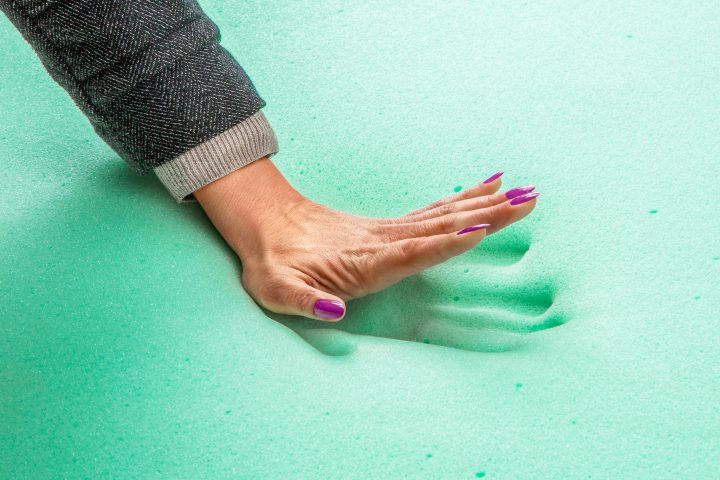
Magical space-age memory foam
Traditional memory foam pillow filling is pretty neat! If you’ve ever felt it, you know what I mean. It has a magical sort of texture that uniquely conforms to pressure.
Visco-elasticity is what makes memory foam so special.
Memory foam has the viscous properties of water. It also has the elastic feel of traditional poly foams. If you rest your head on one, the memory foam will compresses and conform to the shape of your body. When the pressure on the pillow is released, the memory foam slowly resets itself and changes back to its original rectangular shape.
This makes memory foam very good for:
- providing even, comfortable support and
- distributing your body’s weight, eliminating uncomfortable pressure points.
Traditional memory foam pillows are unfortunately NOT moldable.
Most mass-produced memory foam pillows consist of a single piece of foam. This is considered a substantial disadvantage by many users, myself included. No matter how you fluff, smoosh, squash, scrunch or sculpt this solid piece of memory foam, it will always revert to its original rectangular shape. If it feels uncomfortable, you can’t alter its shape to better accommodate your sleeping style like you can with other pillow types.
Shredded memory foam pillows, however, ARE moldable.

As its name implies, “shredded” memory foam filling is simply torn into tiny pieces. The individual pieces of foam move independently, allowing the pillow to be moldable. You can sculpt it much like a down pillow—it will shift and change into whatever shape you desire.
I wanted to try one for myself. “What’s the best shredded memory foam pillow?” I wondered.
It turns out they’re kind of difficult to find. Most pillows filled with shredded memory foam don’t market them as such. Instead they’re “rayon pillows” or “cooling gel foam pillows” or “lion down pillows.” I found most of my search results confusing and inconsistent. I didn’t need cooling gels or a magic rayon case.
*Note* Shredded memory foam pillows are often marketed as “bamboo pillows.” Why? Because bamboo sounds like an environmentally responsible, safe component to use in a pillow. Sellers use the word bamboo in their product descriptions because it appeals to eco-conscious consumers. So where’s the bamboo? The truth is in the fine print: apparently their rayon fabric cases are derived from bamboo.
Instead of a whole pillow, I ordered some shredded memory foam and filled my own pillow case.
I already had a nice zippered cotton cover, so I ordered a bag of shredded memory foam to fill it. It cost me $39.00 with shipping. I’m not one to complain about a few extra dollars for something that you spend a third of your life on, but if you’re shopping for pillow filling strictly based upon price, you should know that you’ll pay a bit more more for shredded memory than poly fiberfill or other more cost-effective fillings.
The shredded memory foam looked like candy-coated popcorn.
My shredded memory foam pillow filling came tightly compressed inside a plastic cylinder to reduce shipping charges. When I opened the bag it expanded to twice its volume. The multicolored pieces all varied in size; most were about 1/4 – 1/2 inches in diameter.
Memory foam is malodorous, funky, fetid and foul!
I opened the bag and my nose quickly reminded me of my previous experiences with memory foam — you might say it jogged my memory (foam). HA!
The strong synthetic odor associated with memory foam is powerful. I’ve tried memory foam pillows before, so this unique chemical smell was something I was very familiar with. Although this shredded memory foam’s stink wasn’t as ridiculous as the pillows I’d tried previously, it was very hard to ignore.
What is this smell? Memory foam is manufactured using polyurethane and several other chemicals. Because of the volatile organic compounds contained, memory foam unfortunately stinks. This is often referred to as “off gassing.” It is a common and well-documented issue and is the most frequent complaint that consumers have with memory foam. The off gassing issue isn’t limited to the smell; there are various reports and studies which indicate that memory foam may be somewhat toxic. *sigh*
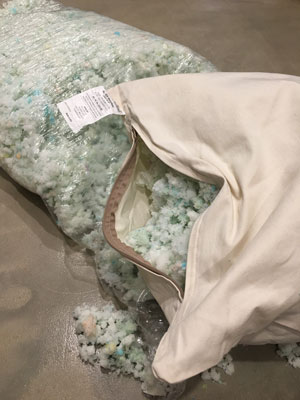
A zippered case makes adjusting a shredded memory foam pillow easy.
Sleeping on a shredded memory foam pillow: my experience
I added what seemed to be an appropriate amount of filling and took my new pillow to my bedroom for a quick test drive. It was completely different than the traditional solid foam pillows I’ve tried. The shredded memory foam was considerably softer feeling. My head sank deep into the pillow — too deep.
I added a bit more filling and after a bit of trial and error, I got the pillow’s loft (height) just where I wanted it. The additional filling also made the pillow a bit more firm, preventing it from bottoming out under the weight of my head.
I should note that not all shredded memory foam pillows offer adjustability with a zippered opening. Personally, I think that the ability to adjust both the firmness and loft of your pillow is indispensable. When you buy something non-adjustable it’s quite likely you’re either positioning your head too high or low.
I slept on it for a couple weeks and formed some conclusions.
A bit of the memory foam “magic” is lost.
Shredded memory foam offers moldability at the cost of some support. Memory foam’s unique ability to conform to your head and neck is negated when it’s been torn into individual pieces. With a solid memory foam loaf, the material adjacent to the compressed area is all attached as a single uninterrupted piece. Traditional memory foam therefore reacts and compresses in coordination, allowing for a more precise “cradling” effect than the shredded memory foam can provide.
Conversely, shredded memory foam pieces each compress independently. This makes the pillow much more more soft and moldable versus firm and supportive.

If your pillow doesn’t keep your head at the correct level, it is likely you will experience back and neck pain.
Because it was so soft, a slight change in my sleeping position caused the loft, or height of the pillow to feel inconsistent. Sleeping one way resulted in slightly more compression of the foam, which made my pillow feel too thin. Moving to a slightly different position caused it to feel too thick. In either circumstance, my pillow required some readjustment.
Does that mean that shredded memory foam is inadequate? Nope. Compared to traditional memory foam pillows, support is slightly diminished. However, the ability to mold my shredded memory foam pillow into the shape I wanted is a far more significant a benefit to me. It was much more comfortable than the traditional memory foam pillows I’d tried previously.
Shredded memory foam is more breathable than traditional memory foam.
Traditional memory foam is not very breathable. A single piece of dense foam doesn’t allow air to circulate freely so it will absorb and retain the warm humid air generated by your body. Alternatively, a breathable pillow filling type will allow warm air to escape while being replaced with fresh, cool air.
Fortunately shredded memory foam offers improved breathability. There’s considerably more negative space for air to flow freely between the pieces of filling inside the pillow. This prevents it from getting uncomfortably warm like a traditional solid-piece memory foam type. It certainly isn’t as breathable as buckwheat hulls or microbead pillow filling, but it isn’t an uncomfortable obstacle to good rest either.
Shredded Memory Foam Verdict
This was far superior to traditional one-piece memory foam pillows. The compromise in support is easily worth the benefits gained. Shredded memory foam is moldable, stays cooler, and is still more supportive than most types of pillows.
Unfortunately, the off-gassing and potential toxicity of memory foam is the deal-breaker for me. I am simply not willing to risk spending 1/3 of my life on something that might not be completely safe. The strange chemical odor pouring out of it is a constant reminder of this potential danger. That said, the danger could be exaggerated. If this isn’t a concern to you, then a shredded memory foam pillow is something you should try.
*Edit 5/16/17* The off gassing seems to be fading away more quickly than my previous memory foam pillows. Two months later, the smell is still noticeable, but substantially less obvious than it was. My previous memory foam pillow seemed perpetually stinky. It ended up in the trash after giving it several months’ opportunity to air out. Perhaps different memory foam manufacturing techniques result in differences in off gassing decay. Despite this positive development, I’m still not a shredded memory foam pillow convert.
*Edit 7/13/18* Having sat in a closet for over a year, I pulled it out for a sniff test. The filling’s chemical odor is no longer noticeable.
Your pillow’s filling (sometimes also called pillow stuffing or filler) defines its character. Depending on the type of pillow filling and the quantity used, your pillow can be totally unique and appropriate to your preferences: soft, firm, supportive, low or high loft. It’s your choice.
What’s the best pillow fill?
Unfortunately no single pillow filling type works for everyone. The best pillow filling varies depending on context. Each type has its own advantages and disadvantages and appeals to a unique audience of sleepy heads. What might work great for some could very well result in neck pain for others. Ultimately, it’s best to try different pillow filling types for yourself, but that’s a difficult proposition with the plentiful options available today.
Following is summary that will help you understand the most popular pillow filling types and the advantages/disadvantages of each.
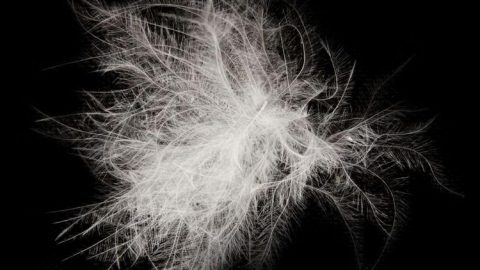
1. Down Pillow Filling
The undercoating of a bird’s feathers is called down. More specifically, it’s the bottom, fluffy part of a bird’s feather. Down holds its loft up to 3 times longer than synthetic alternatives and is very soft.
Hungarian goose down (otherwise known as European white goose down) is considered to be the best quality.
These down clusters are pure white and larger than most other types. A real down pillow contains down only — no feathers. Frequently “down” is sold as a combination of down and feather fill. While feathers are an economical way to add volume, often the feathers’ quills will stick through the pillow poking your pretty face (ouch!) while you sleep.
Our friend Martha Stewart is fond of this type of pillow and suggests that you purchase only high-quality down fill due to its longevity.
“I have pillows on my beds that are 10 to 15 years old,” Martha says. In the long run, good-quality down is the least-expensive way to go since it holds up better than synthetic stuffings, which generally wear out in three to four years.
15 years old? I think Martha must take really good care of her pillows!
If you’re concerned about the well-being of animals, down comes at a considerable price. Down feathers are collected using one of three techniques: 1) post-mortem, after being killed for their meat, 2) live plucking or 3) gathering from live birds. In recent years, manufacturers have responded to these ethical concerns by introducing the “Responsible Down Standard,” a certification aimed at ensuring the humane treatment of birds and the ethical sourcing of down.
Advantages of Down Pillow Filling:
- moldable/malleable – a down pillow tends to hold its shape well, offering good support for your head and neck
- light and cuddly – down pillows are very light (heavy feathers don’t work very well for flying after all!) and soft
- durable – with proper care, a down pillow can last for several years
- sustainable – down is a renewable resource that is biodegradable and recyclable
Disadvantages of Down Pillow Filling:
- absorbs and retains body heat which can make your pillow feel warm and uncomfortable
- consistent refluffing is required to prevent them from flattening out
- difficult to clean
- can be too soft for some, resulting in inconsistent support that elevates your head too high or low
- expensive
- some consider the harvesting of down to be inhumane
Down pillow filling is available at Amazon. You’ll need around 1 lb. to fill a standard size (20×26″) pillow.
Read More: What You Don’t Know About Feather and Down Pillows
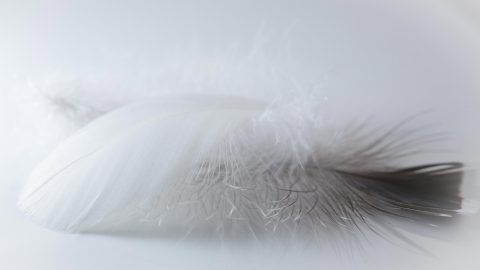
2. Feather Pillow Filling
Feathers are down’s cheap little brother. We recommend you avoid feathers and spend the extra money on real down.
With use, the feathers’ quills shift, gradually aligning themselves so they’re all parallel to each other. This can cause a feather pillow to lose a considerable amount of loft and it may become become flat and uncomfortable. For this reason, manufacturers sometimes add some down clusters to the feathers; this slows degeneration.
Advantages of Feather Pillows:
- cheaper than down
- light and cuddly
- moldable/malleable
Disadvantages of Feather Pillows:
- “at least 15% of owners report a lingering and unpleasant odor.”
- requires consistent fluffing to maintain its loft due to the quills flattening
- difficult to clean
- absorbs and retains body heat which can make your pillow feel warm and uncomfortable
- some consider the harvesting of down to be inhumane
If the negative characteristics of feathers are acceptable and you’d like to save some cash, try this feather and down combo fill available at Amazon. You’ll need around 1 lb. to fill a standard size (20×26″) pillow.
Read More: What You Don’t Know About Feather and Down Pillows
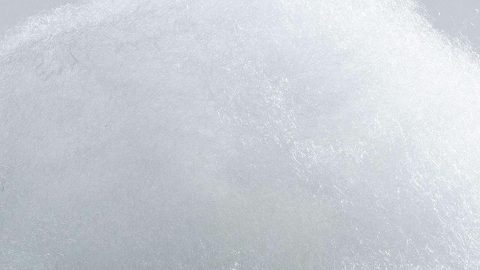
3. Polyester Fiberfill Pillow Filling
Polyester fiberfill, also referred to by it’s trademarked name, Poly-Fil (or Polyfill Stuffing), is a popular option thanks to its low price. It’s lightweight, easy to clean, and did I mention it’s CHEAP? Fiberfill isn’t very breathable, so it can make your pillow fill warm; it will absorb and retain your body heat. Additionally, the fibers tend to clump which can quickly make your pillow feel flat and lumpy. Avoid polyester pillow filling unless you’re specifically looking for the most cost-effective option.
Polyester Pillow Filling Advantages:
- dirt cheap
- easy to clean
- lightweight
Polyester Pillow Filling Disadvantages:
- clumps easily requiring frequent readjustment and a lumpy pillow
- short life span due to the clumping issue
- potentially hazardous to your health and the environment — the production of polyester fibers involves the use of nasty chemical ingredients like formaldehyde, benzene, toluene and other toxins
- not moldable/malleable
- not breathable — can feel warm
It’s easy to find at most big brick and mortar retailers like Walmart. This is currently Amazon’s best seller. You’ll need 1-2 lbs. to fill a standard size (20×26″) pillow.
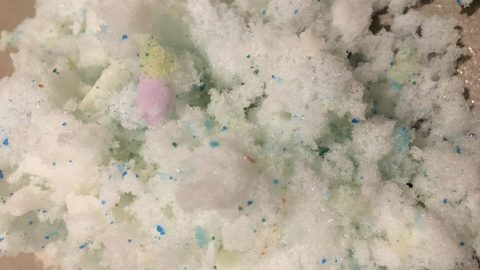 4. Shredded Memory Foam Pillow Filling
4. Shredded Memory Foam Pillow Filling
Memory foam is manufactured using polyurethane and several other chemicals. Because of this, it unfortunately often emits a strong chemical odor. This “off gassing” of volatile organic compounds is a common and well-documented issue. There are various reports and studies which indicate that memory foam may be somewhat toxic.
Toxicity aside, memory foam pillow filling is pretty neat! If you’ve ever felt it, you know what I mean: It’s sort of magical the way it retains its shape. I suspect that it’s this “magic” that makes them so popular; people are immediately impressed with the way memory foam feels.
Most mass-produced memory foam pillows consist of a single piece of box-shaped memory foam. Some consumers swear by them. But for most, the simple fact that most memory foam pillows are not moldable is a deal-breaker. No matter how you squish or sculpt it, the memory foam bounces back to its original rectangular shape. Because of this limitation, most prefer “shredded” memory foam. As the name implies, it’s memory foam that’s been torn into tiny pieces. The individual pieces of foam move independently, allowing your pillow to be moldable.
Advantages of Shredded Memory Foam Pillow Fill:
- doesn’t clump
- moldable/malleable
- offers good support
Disadvantages of Shredded Memory Foam Pillow Fill:
- chemical odor
- potentially dangerous “off-gassing”
- can soften and become too thin when body heat is absorbed, resulting in inconsistent support that doesn’t elevate your head high enough
Shredded memory foam isn’t something your local retailer keeps on the shelves, but Amazon has several options available. You’ll need 2-3 lbs. to fill a standard size (20×26″) pillow.
Read More: That Memory Foam Smell
Read More: Is a Shredded Memory Foam Pillow Better?
 5. Buckwheat Hull Pillow Filling
5. Buckwheat Hull Pillow Filling
Buckwheat hulls are firm yet highly malleable and breathable, which makes them ideal pillow fill.
Full disclosure: we sell buckwheat pillows. We love these things! We’ve tried a lot of different types of pillow filling, and we think nothing beats all-natural, old-fashioned buckwheat hulls. We started manufacturing buckwheat pillows because we thought they were simply the best.
Advantages of Buckwheat Hull Pillow Filling:
- superior support to all other pillow filling — buckwheat hulls will conform perfectly to the shape of your head and neck
- breathable/promotes air flow keeping you cool
- long life-span
- moldable/malleable – it holds its shape and offers terrific support
- eco-friendly
Disadvantages of Buckwheat Hull Pillow Filling:
- buckwheat hulls make a rustling noise when shifted
- heavy — a 20×26″ buckwheat pillow weighs around 8 pounds
- too firm for some — buckwheat hull filling does not collapse under pressure, which can feel “hard” to those acclimated to soft pillow types
Hullo buckwheat hulls are available in 10 or 20 lb. boxes for $49 and $89. All orders ship for free.
Read More: What Are the Benefits of a Buckwheat Pillow?
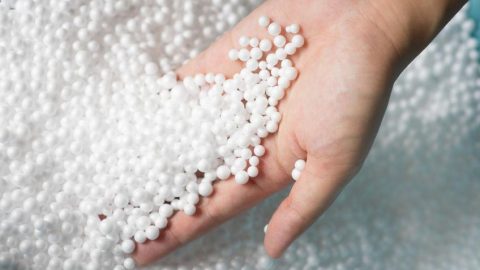 6. Microbead Pillow Pillow Filling
6. Microbead Pillow Pillow Filling
Microbeads are also called “uniform polymer particles.” Most microbeads used in pillows is made from a material called polystyrene. You could call them the synthetic alternative to buckwheat hulls. They share a lot of the same characteristics: they promote air flow and they’re malleable as well. Unfortunately microbeads loose their volume and flatten out more quickly than other pillow filling types. They’re also not very good for the environment.
Advantages of Microbead Pillow Filling:
- breathable — keeps cool at night
- moldable/malleable — it holds its shape and offers good support for your head, neck and shoulders
- extremely lightweight, making them useful in large pillows like bean bags
Disadvantages of Microbead Pillow Filling:
- chemical odor and potentially dangerous “off-gassing”
- no variety of firmness or loft (they’re mostly medium firm, medium loft)
- short life span — microbeads quickly degenerate and flatten out with use
I’ve never tried this product, but the manufacturer claims that these microbeads last longer than other types. They’re apparently smaller and more dense than other types.
Read More: The Microbead Pillow Will (Comfortably) Ruin Us All
7. Shredded Latex Pillow Filling
Latex pillows are becoming quite popular. They offer good support for your head and neck while retaining a soft feel. Like most memory foam pillows, the most popular latex pillows sold are solid box shaped pieces of latex that aren’t moldable. However, shredded latex pillow filling is moldable and malleable.
Manufacturers can call their pillow filling, “natural latex” as long as there is a percentage of natural material in the synthetic blend. I recommend you look for shredded latex pillow filling that is labeled “100% natural latex.”
Advantages of Shredded Latex Pillow Filling:
- moldable/malleable
- breathable — keeps cool at night, although it doesn’t compare to the breathability offered by buckwheat hulls or microbeads
- eco-friendly
Disadvantages of Shredded Latex Pillow Filling:
- “rubbery” odor
- can be too soft for some, resulting in inconsistent support that elevates your head too high or low
- expensive
Amazon has organic shredded latex foam in 5 lbs. bags.
Read More: Shredded Latex Pillow Review
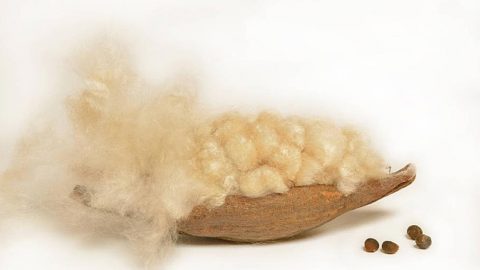 8. Kapok Pillow Filling
8. Kapok Pillow Filling
Kapok, or ceiba pentandra, is a tropical tree native to Mexico that flowers, producing a fluffy, cotton-like material containing hundreds of seeds. This light brown, soft fibre is sometimes called silk cotton. Its soft quality makes it a good alternative to down or polyester pillow fill.
Kapok’s qualities made it a very popular for filling pillows, upholstery, and even life preservers. Kapok’s use dramatically declined upon the introduction of polyester/polyurethane foams, but it is currently experiencing a small revival thanks to its all-natural characteristics.
Advantages of Kapok Pillow Filling:
- free of the potentially toxic materials in many foam pillows
- eco-friendly
- soft texture is a good alternative to those accustomed to foam or down pillows
Disadvantages of Kapok Pillow Filling:
- extremely flammable
- quickly develop lumps, much like polyester foam pillows do
- not moldable, does not hold its shape
Amazon has organic kapok. You’ll need about 1-2 lbs to fill a standard (20×26″) pillow.
Read More: Kapok Pillow Review — A Comfortable and Safe Alternative?
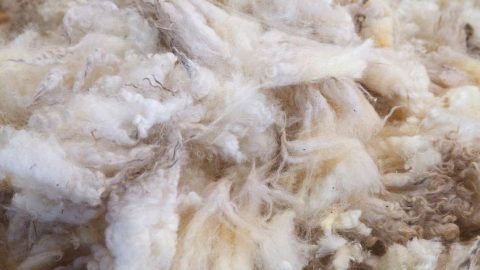 9. Wool Pillow Filling
9. Wool Pillow Filling
Wool’s breathable and insulative qualities make it uniquely suited for use in many different products. For thousands of years it’s been used extensively for diverse products including clothing, blankets, carpeting, insulation and upholstery. Wool however isn’t extensively used as pillow filling due to its tendency to clump into balls, making your pillow lumpy and inconsistent.
Read More: Can a Wool Pillow Help You Sleep Better (Without Foul Odors)?
Advantages of Wool Pillow Filling:
- free of the potentially toxic materials in many foam pillows
- breathable
Disadvantages of Wool Pillow Filling:
- many (myself included) complain of foul odors, particularly in humid environments
- with use, wool quickly becomes lumpy and uncomfortable (see above photo)
- not very moldable, does not hold its shape like down or buckwheat hull filling
- some consider it inhumane
Amazon has 1 LB bags of merino wool. About three pounds will adequately fill a standard size pillow.

10. Cotton Pillow Filling
Cotton is soft and compressible although slightly more firm than traditional pillow filling like down or polyfill. New synthetic materials such as memory foam have relegated cotton to a minority position as pillow filling.
Read More: Is a Cotton Pillow Better than a Down Pillow?
Advantages of Cotton Pillow Filling:
- odorless
- free of the potentially toxic materials in many foam pillows
- breathable
Disadvantages of Cotton Pillow Filling:
- with use, cotton can become lumpy and uncomfortable (it’s worth noting that it will resist clumping better than wool)
- not very moldable, does not hold its shape like down or buckwheat hull filling
Amazon has organic cotton filling available by the pound. About three pounds will adequately fill a standard size pillow.

PrimaLoft™
11. Down Alternative Pillow Filling
Down alternative pillow filling attempts to mimic down’s advantages while improving upon some of down’s disadvantages.
Read More: Are Down Alternative Pillows Superior to Mother Nature’s?
Advantages of Down Alternative Pillow Filling:
- It is far cheaper than genuine down.
- Most down alternative pillows are very easy to clean without damaging them.
Disadvantages of Down Alternative Pillow Filling:
- With use, most down alternative filling will develop lumps.
- They’re not moldable or malleable; they do not hold their shape like genuine down pillows.
- They retain more heat than traditional down pillows.
This down alternative filling is available at Amazon in 1, 2, 3 and 5 lb. bags. About two pounds will adequately fill a standard size pillow. Note that there are a lot of different types of down alternative fillings marketed under different brand names. The quality will vary considerably.
Don’t box yourself in! Make your pillow adjustable!
Adding more or less pillow filling will dramatically change the character of your pillow. Generally speaking, adding more filling will increase the loft of your pillow and make it feel more firm. Conversely, a reduction of pillow filling will result in a softer, thinner pillow. Determining the amount of filling to stuff in your pillow is almost as critical as picking the filling itself.
After the filling has been chosen and stuffed into a fabric case, most bed pillows are immediately sewn shut. Once it’s been sewn shut, there’s no further opportunity for adjustment. Most commercially produced pillow don’t include a zippered opening; it is considered an unnecessary and expensive feature. If you’re making your own pillows, I highly recommend you include a zipper along one of the short edges. This will allow you to add or remove filling, making it easy to adjust the loft and relative firmness/softness to your personal preferences.
* Amazon Affiliate Disclosure: Hulltex LLC (dba Hullo) is a participant in the Amazon Services LLC Associates Program, an affiliate advertising program designed to provide a means for sites to earn advertising fees by advertising and linking to amazon.com

Side sleeping is the most common sleep position. 74% of us are side sleepers. It’s no coincidence—side sleeping is both comfortable and healthy (although some would argue that sleeping on your back is preferable). Sleeping on your side helps your head, neck, and spine maintain a neutral position. A neutral sleeping position keeps all the bits and pieces in your back in in their ideal positions, preventing unnecessary pressure on your discs, muscles and nerves. Keep your spine neutrally aligned and you’ll avoid discomfort (and worse).
Unfortunately, it’s easy to fall into bad sleep habits, especially when we’re young. The consequences of these bad habits often do not become apparent until we hit middle age. Suddenly subtle aches and pains become prevalent and impossible to ignore.
Reasons to learn how to sleep on your side:
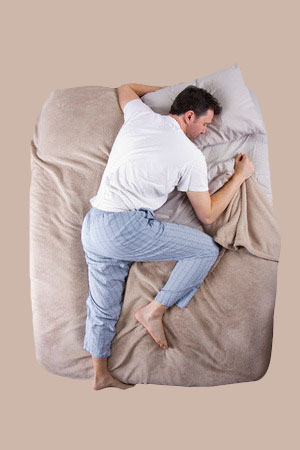
Sleeping on your stomach can result in aches and pains. A hobbit-sized mattress like the one pictured above won’t help either.
You’re a stomach sleeper experiencing discomfort…
Lying on your stomach inevitably results in awkward bends and twists in your spine’s natural curves that can lead to discomfort:
- If you’re using a pillow your neck is likely bent too far upward.
- Your hips can sink too deep into your mattress creating an unnatural downward bend in your lower back.
- Further exacerbating these contortions, your neck has to be twisted ninety degrees to the left or right (you can’t breath into your pillow, after all).
Or you’re a back sleeper experiencing discomfort…
Back sleeping isn’t for everyone. For some it can cause lower back pain and sleep-depriving snoring.
Given this page’s title, I suspect you’ve arrived here with a desire to become part of the comfortable and healthy majority! With a little determination and practice, learning how to sleep on your side is totally doable.
Learn how to sleep on your side with these simple tips:
1. First, be sure you’re using the right pillow. Side sleepers get the best rest on thick, firm pillows.
When on your side, your pillow’s job is to fill the space between your head and your mattress while keeping your body in a neutral sleeping position — your neck and back should be in a straight line without any upward or downward bends in your spine.
Side sleepers will be most comfortable on a firm or extra-firm pillow. Believe it or not, your big ol’ head weighs about 11 lb. Softer pillow types like down tend to collapse under the weight during the night. This loss of support will cause your head and neck to bend downwards, resulting in unnecessary strains that can lead to neck or back pain.
Side sleepers are also advised to use a pillow with more loft (thickness) than other pillow types. This is simply because there is more space to fill between your head and the mattress when on your side than when on your back or stomach. Your pillow needs enough loft to support your neck and head at the appropriate level, keeping your entire neck and back in a straight, neutral sleeping position.
Above all, your side sleeper pillow should be comfortable – trust your instincts! Experiment with different pillow types and find what works for you.
2. Try using positioning pillows.
Extra pillows in the bed can help to keep your body positioned on your side.
Former stomach sleepers: a pillow under your arm can A). help to simulate the feeling of being on your stomach and B). prevent you from rolling onto your stomach.
Former back sleepers: a heavy pillow placed behind your back will help to prevent you from rolling to your back. You can also try using a pair of pillows on either side of your body if you tend to roll from one side of your body to the other. Buckwheat and millet hull pillows will both work well — they’re heavy enough that they’ll stay put in your bed while you sleep.
3. Sew a tennis ball into the front or back of a pajama shirt.
It sounds a little silly, but apparently it works for some. If you tend to roll onto your stomach, sew the ball into the front of your shirt. Conversely, if you tend to roll onto your back, sew the ball into the back of your shirt. If you drift away from your side sleeping position, the tennis ball will tell you, “oh no you don’t…”
4. Try sleeping on a narrow sofa.
If you’ve got no space to roll onto your stomach or back, you’ll be forced to stay on your side. Give the sofa a couple weeks of side sleeping practice and then switch back to your bed. With any luck, it’ll be easier to maintain a consistent side-sleeping position throughout the night.
5. Monitor your progress.
It’s hard to know what’s working when you’re asleep! Take note if/when you wake up on your side in the morning. Keep track of the behaviors that allow you to comfortably sleep on your side and then purposely strive to turn those behaviors into habit.
6. Finally, be persistent.
The most important thing you can do is keep at it. It can be very difficult to break an old habit.
It can be incredibly difficult to resist the urge to roll into your habitual sleep position. It’s hard to think rationally when you’re exhausted! Always roll back to your side when you catch yourself positioned otherwise.
Try my recommendations and be sure let us know about your own tips and experiences in the comments below.
 The fantastic bamboo pillow is everywhere. They’ve recently exploded in popularity. According to Google Trends, they’re even more popular than traditional down pillows! People seem to like them: the reviews are generally positive.
The fantastic bamboo pillow is everywhere. They’ve recently exploded in popularity. According to Google Trends, they’re even more popular than traditional down pillows! People seem to like them: the reviews are generally positive.
Despite their prevalence, I only noticed them recently. They caught my attention for one reason: bamboo pillows appear to be a “green” product.
I try to shop responsibly, purchasing products that are ecologically responsible when possible. A pillow made from the bamboo plant, a plentiful renewable resource, seemed like an environmentally friendly and safe product for a tree-hugger like myself.
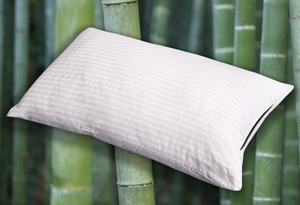
Don’t be fooled, hippy! This thing’s got zero green cred.
What is a bamboo pillow?
The name clearly implies that a primary component must be bamboo. As it turns out, the majority are filled with shredded memory foam, a petroleum-based product. The fabric outer shell or case, is most commonly a blend of rayon and polyester.
So where’s the bamboo? The truth is in the fine print: apparently the case’s rayon fabric is derived from bamboo.
Yes, bamboo pillows are essentially just a memory foam pillow with a rayon pillow case.
According to popular product descriptions, these magical bamboo pillows are:
- environmentally friendly
- hypoallergenic
- antimicrobial
- biodegradable
- cooler than traditional pillows
- adjustable
- supportive and moldable

Future generations will call this idyllic place, “Shredded Memory Foam Falls”
Are bamboo pillows environmentally friendly?
Bamboo sounds like a responsible and safe component to use in a pillow. Marketers love to use the word bamboo in their product descriptions, because it appeals to eco-conscious consumers like me. Unfortunately, manufacturing bamboo fabric, i.e., rayon, is not harmless to the environment.
The most common way to produce rayon involves the “viscose” process.
A strong chemical bath dissolves the cellulose material derived from bamboo. Then it is treated with toxic chemicals like carbon disulphide, caustic soda, ammonia, acetone and sulphuric acid until it solidifies into useable fibers. Production releases hazardous air pollutants. In addition, 50% of the solvents used are dumped as wastewater.
Rayon isn’t the only pollutant used in the production of these pillows.
Manufacturing memory foam and polyester both result in the release of carcinogenic materials into our air and water causing significant environmental damage. It’s unclear if there are adverse health issues associated with long-term exposure to the chemicals contained in memory foam.
Verdict: You won’t find a bamboo pillow on mother nature’s bed.
It’s misleading to suggest that viscose rayon, polyester and memory foam are environmentally-friendly materials, particularly when compared to traditional all-natural fabrics and fill types.
Are bamboo pillows hypoallergenic?
Hypoallergenic claims resonate with consumers and help to sell products. What exactly is implied? Unfortunately it is very vague because there is no regulation in the United States that defines or governs the use of the term. Blakiston’s Medical Dictionary, however, defines it:
“Hypoallergenic” – Adjective
A term applied to a preparation in which every possible care has been taken in formulation and production to ensure minimum instance of allergic reactions.
Are the makers of these pillows taking “every possible care” in the creation of their hypoallergenic products?
First, let’s consider the bamboo pillow’s primary component, memory foam. A quick search of “memory foam allergy” reveals substantial and credible user complaints. Headaches, rashes and similar allergic-type reactions are all documented issues.
No credible evidence exists that suggests that memory foam is less likely to cause allergic reactions than other pillow fill types.
As it happens, dust mites are the true allergy menace and no pillow type is immune to them.
Dust mites are tiny organisms that live in the dust in your house and are one of the top five most common allergens. If you’re experiencing an allergic reaction to a pillow that you’ve been using for awhile, chances are you’re allergic to dust mites, not the pillow itself.
Dust mite allergies are very similar to a pollen allergy except that the symptoms occur year round instead of just seasonally. All bedding is susceptible to dust mite infestations, including the so-called bamboo pillow.
Verdict: To call bamboo pillows hypoallergenic is misleading.
Saying that these pillows are hypoallergenic is, at best, an overstatement. Additionally, a lack of regulation and oversight makes the term hypoallergenic somewhat meaningless.
Are bamboo pillows antimicrobial?
Bamboo is unique in that it contains a substance called bamboo-kun. This antimicrobial agent gives bamboo a natural resistance to pest and fungi infestation. Unfortunately, the chemical processes used to produce rayon destroys any of bamboo’s antimicrobial properties. There is no trace of the original bamboo plant’s resistance to bacteria in the finished rayon product.
Verdict: A bamboo pillow is not antimicrobial.
Are bamboo pillows biodegradable?
Biodegradable materials can break down into natural materials without causing harm to the environment. Memory foam and polyester are not biodegradable. Depending on the specific types used, these materials will sit around for hundreds of years in the landfill. Rayon, is 90% biodegradable, but it is a very small portion of the pillow’s total mass.
Verdict: A bamboo pillow is not biodegradable.
In most bamboo pillows, only a small percentage of the fabric pillow case is truly biodegradable.

A breathable pillow is a cool pillow.
Are bamboo pillows cool?
If air is able to circulate through a pillow’s fill, it’ll stay cool while you sleep. Unfortunately, memory foam does not have a reputation for being breathable. It restricts airflow, causing the pillow to build up and retain body heat. I’ve tried several different types of memory foam pillows over the years and none could be described as being “cool.”
Most bamboo pillows, however, contain “shredded” memory foam. Manufacturers simply tear this shredded fill into little pieces from memory foam. These individual pieces allow for better air circulation though the pillow vs a traditional solid piece of memory foam. However, for some reason, many of the available bamboo pillows are enclosed in a foam enclosure or case (this is in addition to the rayon/poly outer fabric case) that restricts airflow. This negates much of the cooling ability gained from using shredded vs. traditional memory foam.
Well, maybe the rayon/polyester blend, err “bamboo” fabric is extra breathable? It’s not more breathable than traditional bedding fabrics like linen or cotton that are well-known for their breathability.
Verdict: They aren’t any cooler than traditional pillows.
A bamboo pillow is no better at keeping you cool than a traditional pillow filled with down or similar fill. Memory foam’s reputation for retaining heat certainly doesn’t suggest that it’s superior.
The U.S. government has taken action against some sellers of bamboo pillows.
There have been attempts by the government to deal with the issue of deceptive marketing of bamboo products. For example, several large retailers were warned in 2009 by the FTC about the blatantly misleading bamboo claims. It didn’t end with warnings…
“Sears Holdings agreed to pay $475,000 and remove false advertising from its line of “100% pure bamboo” products, which were anything but. Sears was the first of several large companies, including Amazon.com and Macy’s, that agreed to pay fines totaling nearly $1.3 million for violating for violating the Textile Products Identification Act…” –Time Magazine
The settlements set a precedence and larger retailers are mostly adhering to the FTC’s guidance. However, the deceptive marketing practices remain prevalent amongst smaller retailers. At the time of writing, several Amazon sellers are making “100% bamboo” claims.
Because of these actions, most reputable sellers today no longer allege that these pillows are 100% bamboo. Even without that simple falsity, most bamboo pillow benefits are grossly overstated.
Bamboo pillow benefits are exaggerated, but they’re not all bad…
The shredded memory foam contained in most bamboo pillows is impressive. If you’ve ever felt it, you know what I mean. It has a magical sort of texture that uniquely conforms to pressure. Memory foam has the viscous properties of water, but the elastic feel of traditional poly foams. These unique characteristics make memory foam pillows very popular.
If you rest your head on one, the memory foam will compresses and conform perfectly to the shape of your body. When you release the pressure on the pillow, the memory foam slowly resets and changes back to its original shape.
This makes memory foam effective at evenly distributing your body’s weight, eliminating pressure points.
Memory foam is quite good at providing support for your head and neck. It evenly cradles the weight of your head eliminating any pain-causing pressure points, allowing your muscles and joints to completely relax. The fact that many bamboo pillows are adjustable via a zippered opening is a big plus. This allows you to fine tune your pillow’s loft (thickness) to your personal preferences.
I’ve tried a shredded memory foam pillow myself. (without a rayon, err bamboo… pillow case).
It impressed me. My shredded memory foam pillow was far superior to all the traditional one-piece memory foam pillows I’d tried before.
Despite the comfort, the off-gassing odor was a constant annoying reminder of the potential health and environmental associated with memory foam. For that reason, my shredded memory foam pillow didn’t win a permanent place on my bed.
Try an alternative with real green credentials.
If you’ve considered purchasing a bamboo pillow based upon their supposed green image, ignore the hype. Many popular pillow filling alternatives are safe, both for us and the environment:
As for a pillow’s fabric case, we recommend cotton. It’s the overwhelming favorite for use in bedding products for a reason… It’s soft, breathable and cheap to manufacture. Unfortunately, like rayon and other types of fabric, the production of cotton often releases toxic chemicals into the environment. For this reason, we encourage consumers to purchase certified organic cotton bedding manufactured to OEKO-TEX standards.
Have you ever slept on a buckwheat pillow?
They’re sort of like a bean bag for your head. A buckwheat pillow’s unique filling allows it to conform perfectly to the shape of your head and neck while keeping you comfortable and cool all night long.
We manufacture our product, Hullo, responsibly. We only use the best organic and all natural materials that are biodegradable. They’re safe for both your family and the environment.
Give Hullo a try. Discover what true sleep is really like! Don’t take my word for it, check out our customer’s reviews:
“First buckwheat pillow, will never go back to anything else. Searched far and wide for a replacement to my toxic memory foam pillow, and was curious and willing to try anything to help my neck support, especially as a side sleeper. Pillow arrived, perfect condition, and I have yet to remove any of the original filling (you can adjust the volume of the pillow by adding and subtracting more buckwheat hulls). Took about 1 night to understand how to get comfortable, and now most other pillows feel broken. Believe the hype, and protect your family with better products in your home. Start with a Hullo pillow, you won’t regret it!” – Hullo customer, C. Conners
Read More: Is a Shredded Memory Foam Pillow Better?
Read More: What’s the Best Memory Foam Pillow? (They’re Not All the Same)
Read More: “That Memory Foam Smell”

